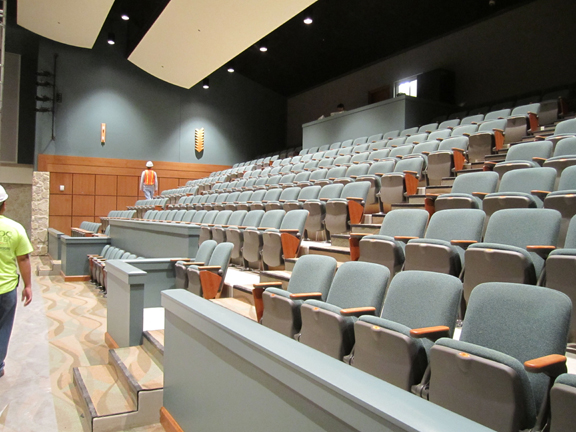Those who have been reading for a number of years may recall that I have been on an advisory committee for the performing arts portion of a community center the Salvation Army is building with the bequest of Joan Kroc. I thought it was only a year ago, but it has actually been over two years since I attended the ground breaking ceremony for the center. Today I had the opportunity to tour the facility before its official opening just after the new year. I had been looking at a lot of plans so it was gratifying to walk through the actual spaces and see elements that I suggested they add.
With the official opening nearly two months away, there is still some work being done. Enough of it was complete that we had to take a circuitous route around the complex and peer through windows into rooms that had been completed and were awaiting final inspection.
Just by way of comparison, here is the front of Kroc Center Hawaii now versus the empty fields in the pictures I took at the ground breaking.
You can take a look at their website for all the programs they will offer which includes a pre-school, after school programs and memberships to their athletic facilities. What I am sure families will really love is the POOLS!
Of course, the part I was most interested in was the theatre space. If you can believe it, I was actually pushing for a venue that was more like my own to provide an alternative rental facility for all those people I have to turn away. There is nothing else really on my side of the county and this is where all the population growth is. As much as I am interested in the theatre portion, I feel the entire project will be a real benefit to the community.
However, the Salvation Army wanted a more multi-purpose space to serve their worship services and provide the opportunity for weddings, banquet assemblies, conference trainings, etc as a supplement to their ballrooms. So there are some nice permanent seating areas.
And then a wide area for temporary seating, tables, etc, leading up to a low stage. They had some pretty nifty state of the art technology and a beautiful sound system which made me a little jealous.
Being the arts administration geek that I am, I was already mentally writing procedures and policies to suggest to whomever they hire to run the place. I suspect that even though the venue lacks many of the features my theatre possesses, they will see a level of demand that will force them to decide between rentals and their own programs.






This is such a thought-provoking post! It’s fascinating to consider how everyday beauty in design, even in functional spaces like…